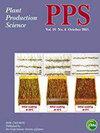旱作直播水稻深播:不同品种间成苗和产量的差异
IF 1.3
3区 农林科学
Q2 AGRONOMY
引用次数: 0
摘要
水稻干播技术(DDSR)在亚洲缺水地区的应用越来越广泛。当干旱发生时,深播可以使发芽的种子利用地表下的剩余水分。我们的目的是研究不同播种深度对DDSR作物生长的影响。两个产量试验,一个在菲律宾,另一个在日本,在雨水灌溉的低地建立,但没有发生干旱。在所有试验中,与1 ~ 2 cm播种深度相比,6 ~ 7 cm播种深度降低了出苗率(25% vs. 73%),导致产量降低(3.5 vs. 4.4 t ha - 1)。深播下的相对产量(深播/浅播)与出苗率呈显著正相关。无显著减产的品种在深播条件下仍保持较高出苗率(约30%)。不同品种深播后的出苗能力差异很大:8 ~ 10 cm的出苗率为0% ~ 18%,6 ~ 7 cm的出苗率为11% ~ 44%。在菲律宾旱季干旱条件下进行了辅助田间试验:当土壤表面严重干燥时,深播比浅播增加出苗率(41%比5%)。研究结果表明,选择耐深播品种是深播技术应用的前提条件,今后的深播育种应以耐深播品种为重点。图形抽象本文章由计算机程序翻译,如有差异,请以英文原文为准。
Deep sowing of dry direct-seeded rice: cultivar differences in seedling establishment and grain yield
ABSTRACT Dry direct seeding of rice (DDSR) is being increasingly used in water-scarce areas across Asia. When drought occurs, deep sowing may enable germinating seeds to utilize the residual moisture below the surface. Our objective was to examine the effects of different sowing depths on DDSR crop growth. Two yield experiments, one in the Philippines and the other in Japan, were established in rainfed lowlands, but drought did not occur. Across the experiments, sowing at a depth of 6 to 7 cm reduced the percentage of emergence compared with sowing at a depth of 1 to 2 cm (25% vs. 73%), which resulted in lower yield (3.5 vs. 4.4 t ha−1). The relative yield (deep-sowing/shallow-sowing) was positively correlated with the percentage emergence under deep sowing. Cultivars with no significant yield reduction under deep sowing maintained high emergence (>30%) under deep sowing. Seedling’s ability to emerge after deep sowing greatly differed among cultivars: the percentage emergence ranging from 0% to 18% from a depth of 8 to 10 cm, and from 11% to 44% from a depth of 6 to 7 cm. An ancillary field experiment was conducted under drought during the dry season in the Philippines: deep sowing increased the percentage emergence compared with shallow sowing (41% vs. 5%), when the soil surface was severely dry. Our results suggest that choosing cultivars that can tolerate deep sowing is a prerequisite for using deep sowing in DDSR, and that future breeding of DDSR should focus on this tolerance. Graphical abstract
求助全文
通过发布文献求助,成功后即可免费获取论文全文。
去求助
来源期刊

Plant Production Science
农林科学-农艺学
CiteScore
5.10
自引率
4.00%
发文量
27
审稿时长
>36 weeks
期刊介绍:
Plant Production Science publishes original research reports on field crops and resource plants, their production and related subjects, covering a wide range of sciences; physiology, biotechnology, morphology, ecology, cropping system, production technology and post harvest management. Studies on plant production with special attention to resource management and the environment are also welcome. Field surveys on cropping or farming system are also accepted. Articles with a background in other research areas such as soil science, meteorology, biometry, product process and plant protection will be accepted as long as they are significantly related to plant production.
 求助内容:
求助内容: 应助结果提醒方式:
应助结果提醒方式:


